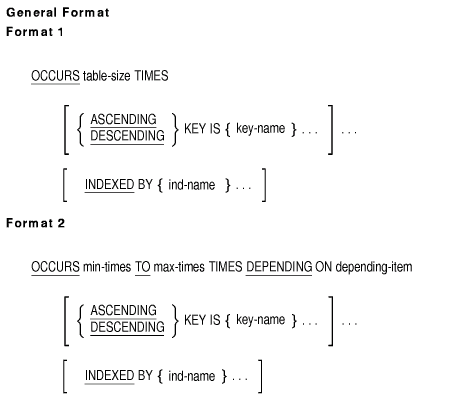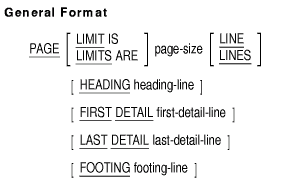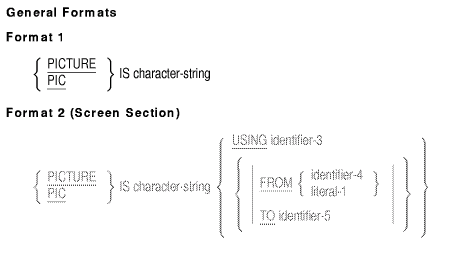Table 5-8 PICTURE Clause Symbols
| Picture Clause Symbol |
Function |
|
A
|
Represents a character position that can contain only an alphabetic
character. An alphabetic character belongs to the set of characters: A
to Z, a to z, and the space.
|
|
|
Can occur more than once.
|
|
|
Counts toward the size of the item.
|
|
B
|
Represents a character position into which a space is inserted.
|
|
|
Can occur more than once.
|
|
|
Counts toward the size of the item.
|
|
N
|
For USAGE IS DISPLAY, represents a character position that can contain
any 2-byte character from the national character set. This is available
only if /NATIONALITY=JAPAN or
-nationality japan
is specified.
|
|
P
|
Specifies an assumed decimal scaling position, defining the location of
the decimal point when one is not specified in
character-string.
|
|
|
Can occur more than once, but only as a contiguous string of Ps at
either the leftmost or rightmost end (not both) of
character-string. The assumed decimal point character (V) is
redundant when specified. However, when it is specified, V can appear
to the left of the leftmost P or to the right of the rightmost P.
|
|
|
Does not count toward the size of the item. However, each P counts
toward the maximum number of digit positions (31) in a numeric or
numeric edited item.
|
|
|
Cannot be used if an explicit decimal point (.) appears in
character-string.
|
|
|
In certain operations that refer to an item with P characters in
character-string, the compiler treats each P position as if it
contained the value zero. For example, an item with PICTURE 99PPP can
have 100 unique values that range from 0 to 99,000 (0, 1000, 2000, ...,
99,000). An item with PICTURE PP9 can have 10 unique values (0, .001,
.002, ... .009). These operations are any of the following:
- Any operation requiring a numeric sending operand
- A MOVE statement where the sending operand is numeric and its
PICTURE
character-string contains the symbol P
- A MOVE statement where the sending operand is numeric edited and
its PICTURE
character-string contains the symbol P, and the receiving
operand is numeric or numeric edited
- A comparison operation where both operands are numeric
|
|
|
In all other operations, the compiler ignores the digit positions
specified with the symbol P and does not count them toward the size of
the operand.
|
|
S
|
Indicates the presence of an operational sign, but does not specify the
sign representation or position.
|
|
|
Can occur only once, as the leftmost character in
character-string.
|
|
|
Does not count toward the size of the item unless the data or screen
description entry contains a SIGN IS SEPARATE clause. If the SIGN
clause does not appear in the item's data description, S is equivalent
to SIGN IS TRAILING.
|
|
V
|
Specifies the location of the assumed decimal point.
|
|
|
Can occur only once.
|
|
|
Does not count toward the size of the item.
|
|
|
Cannot be used if an explicit decimal point (.) appears in the PICTURE.
|
|
X
|
For USAGE IS DISPLAY, represents a character position that can contain
any character from the computer character set. For USAGE IS COMP-5 or
USAGE IS COMP-X, represents a byte of computer storage.
|
|
|
Can occur more than once.
|
|
|
Counts toward the size of the item.
|
|
Z
|
Represents a leading digit position that is replaced by a space when
its value and the value of the digits to its left are zero.
|
|
|
Can occur more than once.
|
|
|
Counts toward the size of the item.
|
|
|
Use of Z excludes the use of the asterisk (*) for zero suppression and
replacement.
|
|
9
|
Represents a digit position that can contain only the digits 0 to 9.
|
|
|
Can occur more than once.
|
|
|
Counts toward the size of the item.
|
|
0
|
Represents a character position into which 0 is inserted.
|
|
|
Can occur more than once.
|
|
|
Counts toward the size of the item.
|
|
/
|
Represents a character position into which a slash (/) is inserted.
|
|
|
Can occur more than once.
|
|
|
Counts toward the size of the item.
|
|
,
|
Represents a character position into which a comma (,) is inserted. +
|
|
|
Can occur more than once.
|
|
|
Counts toward the size of the item.
|
|
.
|
Represents a character position into which a decimal point (.) is
inserted. It also represents the decimal point for alignment purposes. +
|
|
|
Can occur only once.
|
|
|
Counts toward the size of the item.
|
|
|
Cannot be used if V or P appears in
character-string.
|
|
+ --
|
Represents the editing sign control symbols, the plus sign (+) and
minus sign (-).
|
|
|
Each can occur more than once.
|
|
|
Each counts as one character toward the size of the item.
|
|
|
character-string can contain either a plus sign (+) or minus
(-), but not both. Also, the use of either character excludes the use
of both CR and DB.
|
|
CR DB
|
Represents the editing sign control symbols, credit (CR) and debit (DB).
|
|
|
Each can occur only once, as the two rightmost character positions.
|
|
|
Each counts as two characters toward the size of the item.
|
|
|
character-string can contain either CR or DB, but not both.
Also, the use of either excludes the use of the plus sign (+) and minus
sign (-) as fixed insertion characters.
|
|
*
|
Represents a leading digit position that is replaced by an asterisk (*)
when its value and the values of all digit positions to its left are
zero.
|
|
|
Can occur more than once.
|
|
|
Counts toward the size of the item.
|
|
|
Use of an asterisk (*) excludes the use of Z for zero suppression and
replacement.
|
|
cs
|
Represents a character position into which the currency symbol is
inserted. This symbol is either the currency sign ($) or the character
specified in the CURRENCY SIGN clause of the SPECIAL-NAMES paragraph or
(on OpenVMS) the character specified at DCL command level in the
definition of the SYS$CURRENCY logical name.
|
|
|
Can occur more than once.
|
|
|
Counts as one character toward the size of the item.
|





